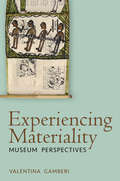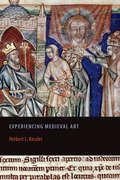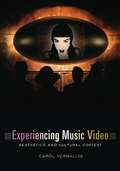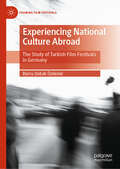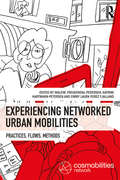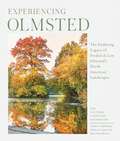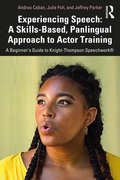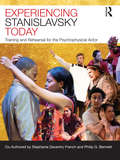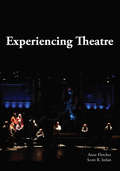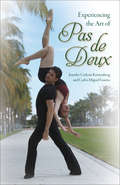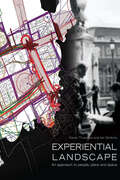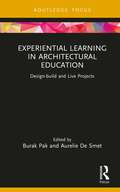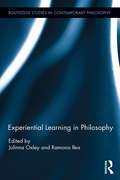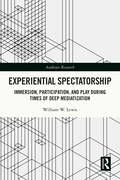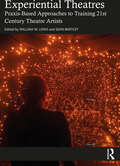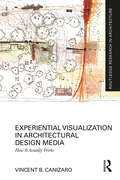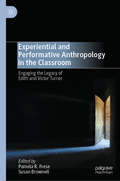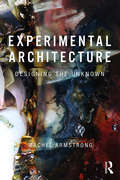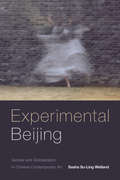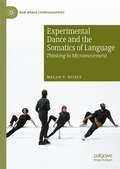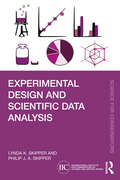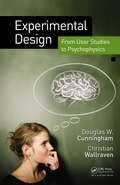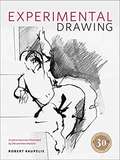- Table View
- List View
Experiencing Liveness in Contemporary Performance: Interdisciplinary Perspectives (Routledge Advances in Theatre & Performance Studies)
by Matthew Reason Anja Mølle LindelofThis volume brings together dynamic perspectives on the concept of liveness in the performing arts, engaging with the live through the particular analytical focus of audiences and experience. The status and significance of the live in performance has become contested: perceived as variously as a marker of ontological difference, a promotional slogan, or a mystical evocation of cultural value. Moving beyond debates about the relationship between the live and the mediated, this collection considers what we can know and say about liveness in terms of processes of experiencing and processes of making. Drawing together contributions from theatre, music, dance, and performance art, it takes an interdisciplinary approach in asking not what liveness is, but how it matters and to whom. The book invites readers to consider how liveness is produced through processes of audiencing - as spectators bring qualities of (a)liveness into being through the nature of their attention - and how it becomes materialized in acts of performance, acts of making, acts of archiving, and acts of remembering. Theoretical chapters and practice-based reflections explore liveness, eventness and nowness as key concepts in a range of topics such as affect, documentation, embodiment, fandom, and temporality, showing how the relationship between audience and event is rarely singular and more often malleable and multiple. With its focus on experiencing liveness, this collection will be of interest to disciplines including performance, audience and cultural studies, visual arts, cinema, and sound technologies.
Experiencing Materiality: Museum Perspectives
by Valentina GamberiRepresenting a cutting-edge study of the junction between theoretical anthropology, material culture studies, religious studies and museum anthropology, this study examines the interaction between the human and the nonhuman in a museum setting usually defined as ‘non-Western’, ‘non-scientific’ and ‘religious.’ Combining an on-site analysis of exhibitive spaces with archival research and interviews with museum curators, the chapters highlight contradictions of museum practices, and suggests that museum practitioners use museum spaces and artefacts as a way of formulating new theoretical stances in material culture studies, thus viewing museums as producers of theories together with affective engagements.
Experiencing Medieval Art (Rethinking the Middle Ages)
by Herbert L. KesslerExperiencing Medieval Art is an extensive revision and expansion of the author’s Seeing Medieval Art, originally published in 2004. Renowned art historian Herbert L. Kessler considers often-strange objects and the materials of which they are made, circumstances of production, the conflictual relationship between art objects and notions of an ineffable deity, the context surrounding medieval art, the playfulness of art and the formal movements it engaged, as well as questions of apprehension, aesthetics, and modern presentation. Kessler introduces the exciting discoveries and revelations that have revolutionized the understanding of medieval art and identifies the vexing challenges that still remain. Examining such well-known monuments as the stained glass in Chartres cathedral, mosaics in San Marco Venice, and Utrecht Psalter, as well as newly discovered works – including the frescoes in Rome’s "aula gotica" and a twelfth-century aquamanile in Hildesheim – Kessler makes the complex history of medieval art accessible for students of art history, teachers in the field, and scholars of medieval history, theology, and literature.
Experiencing Music Video: Aesthetics and Cultural Context
by Carol VernallisHere at last is a study that treats music video as a distinct multimedia artistic genre, different from film, television, and indeed from songs themselves. Carol Vernallis describes how musical, visual and verbal codes work together in music video and reveals modes of representing race, class, gender, and sexuality that characterize the music video form.
Experiencing Music Video: Aesthetics and Cultural Context
by Carol VernallisMusic videos have ranged from simple tableaux of a band playing its instruments to multimillion dollar, high-concept extravaganzas. Born of a sudden expansion in new broadcast channels, music videos continue to exert an enormous influence on popular music. They help to create an artist's identity, to affect a song's mood, to determine chart success: the music video has changed our idea of the popular song.Here at last is a study that treats music video as a distinct multimedia artistic genre, different from film, television, and indeed from the songs they illuminate—and sell. Carol Vernallis describes how verbal, musical, and visual codes combine in music video to create defining representations of race, class, gender, sexuality, and performance. The book explores the complex interactions of narrative, settings, props, costumes, lyrics, and much more. Three chapters contain close analyses of important videos: Madonna's "Cherish," Prince's "Gett Off," and Peter Gabriel's "Mercy St."
Experiencing National Culture Abroad: The Study of Turkish Film Festivals in Germany (Framing Film Festivals)
by Burcu Dabak ÖzdemirImmigrant film festivals are multifaceted events where complex networks of identities and symbolic values are constructed, circulated, and debated through various channels, including program screenings, ancillary events, press releases, financial backing, and audience engagement. As such, immigrant film festivals can be seen as discourse-producing practices. Based on this idea, this book offers a comprehensive study of three prominent Turkish film festivals in Germany: the International Frankfurt Turkish Film Festival, the Nuremberg Turkey/Germany Film Festival, and the Munich Turkish Film Days. The overarching objective is to comprehend the multifaceted influence of these festivals on the construction of discourses on Turkish immigrant identity while also seeking to illuminate how these festivals reshape both the host country and the country of origin and produce ideas for Turkish immigrants This is achieved through an examination of the diverse representation strategies engendered by these festivals. By employing a multifaceted research approach—including content analysis, audience studies, semi-structured interviews with festival managers, and participant observation—this study seeks to provide a nuanced understanding of the complex interplay between immigrant film festivals, cultural identity formation, and the socio-political dynamics within both the host and origin countries. Through rigorous scholarly inquiry, it aims to contribute to academic discourse on the role of film festivals in shaping cultural narratives, fostering intercultural dialogue, and facilitating processes of integration and belonging within immigrant communities.
Experiencing Networked Urban Mobilities: Practices, Flows, Methods (Networked Urban Mobilities Series)
by Malene Freudendal-Pedersen Katrine Hartmann-Petersen Emmy Laura Perez FjallandExperiencing Networked Urban Mobilities looks at the different experiences of networked urban mobilities. While the focus in the first book is on conceptual and theory-driven perspective, this second volume emphasizes the empirical investigation of networked urban mobilities. This book is a resource for researchers interested in the field to gain easy access and overviews of different themes and approaches represented in the mobilities paradigm.
Experiencing Olmsted: The Enduring Legacy of Frederick Law Olmsted's North American Landscapes
by Charles Birnbaum The Cultural Landscape Foundation Dena Tasse-Winter Arleyn Levee200 Iconic Landscapes That Define North America Frederick Law Olmsted is the father of American landscape architecture. His firm, and the successor firms that sprung from it, worked through the nineteenth and twentieth centuries to shape some of our most beloved green spaces, including national, state, and city parks, suburban neighborhoods, and academic campuses. He is most famous for creating New York&’s Central and Prospect Parks, Stanford University&’s campus, and the Capitol Grounds. What is less known and surprising about his legacy is that he worked widely across North America. By highlighting 200 iconic landscapes, many of which are still open to the public today, Experiencing Olmsted brings a fresh approach to the firms&’ work and philosophy. It highlights not only grand city parks, but also other public venues born out of a desire for social equity. Olmsted was an early voice for parks as democratic spaces that could be reached on foot by a large percentage of any city&’s populace. He viewed parks as restorative places—what he termed &“the lungs of a city.&” Brimming with contemporary and archival photography as well as original drawings and plans, this truly remarkable record brings these places to vivid life.
Experiencing Speech: A Beginner's Guide to Knight-Thompson Speechwork®
by Jeffrey Parker Andrea Caban Julie FohExperiencing Speech: A Skills-Based, Panlingual Approach to Actor Training is a beginner’s guide to Knight-Thompson Speechwork®, a method that focuses on universal and inclusive speech training for actors from all language, racial, cultural, and gender backgrounds and identities. This book provides a progression of playful, practical exercises designed to build a truly universal set of speech skills that any actor can use, such as the ability to identify, discern, and execute every sound found in every language on the planet. By observing different types of flow through the vocal tract, vocal tract anatomy, articulator actions, and how these components can be combined, readers will understand and recreate the process by which language is learned. They will then be introduced to the International Phonetic Alphabet (IPA) and will practice using the IPA for narrow transcription of speech sounds. The book also offers both an intellectual and physical understanding of oral posture and how it contributes to vocal characterization and accent work. This approach to speech training is descriptive, giving students a wide and diverse set of speech sounds and skills to utilize for any character in any project, and it establishes a foundation for future accent study and acquisition. Experiencing Speech: A Skills-Based, Panlingual Approach to Actor Training is an excellent resource for teachers and students of speech and actor training, as well as aspiring actors looking to diversify their speech skills.
Experiencing Stanislavsky Today: Training and Rehearsal for the Psychophysical Actor
by Stephanie Daventry French Philip G. BennettThis pioneering introduction to Stanislavsky's methods and modes of actor training covers all of the essential elements of his System. Recreating 'truthful' behaviour in the artificial environment, awareness and observation, psychophysical work, given circumstances, visualization and imagination, and active analysis are all introduced and explored. Each section of the book is accompanied by individual and group exercises, forming a full course of study in the foundations of modern acting. A glossary explains the key terms and concepts that are central to Stanislavsky's thinking at a glance. The book's companion website is full of downloadable worksheets and resources for teachers and students. Experiencing Stanislavsky Today is enhanced by contemporary findings in psychology, neuroscience, anatomy and physiology that illuminate the human processes important to actors, such as voice and speech, creativity, mind-body connection, the process and the production of emotions on cue. It is the definitive first step for anyone encountering Stanislavsky's work, from acting students exploring his methods for the first time, to directors looking for effective rehearsal tools and teachers mapping out degree classes.
Experiencing Theatre
by Anne Fletcher Scott R. Irelan"Experiencing Theatre completely engages the beginning theatre student in the art of theatre. Students become playwrights, dramaturges, actors, directors, designers, adapters and collaborators though dynamic readings and excercises. This text gives them a great awareness of the work of being a theatre artist. Teachers have long strived towards creating these opportunities for their Intro students--finally a text that will make it happen." --Barbara Burgess-Lefebvre, Robert Morris University
Experiencing the Art of Pas de Deux
by Jennifer C. Kronenberg Carlos M. Guerra"An insightful read from one of the ballet world’s most beloved married couples!"--Melinda Roy, former principal dancer, New York City Ballet "Wonderfully complete and instructive, written by two artists who have lived what they write about and are sharing their life experience from a deep and very human viewpoint. Bravo!"--Donald Mahler, former director, Metropolitan Opera Ballet "Perfect for inspiring dancers who want to learn more about the art of partnering."--Lauren Jonas, cofounder and artistic director, Diablo Ballet "An effective and lively resource to add to a dancer and teacher’s partnering skills toolkit."--Dean Speer, author of On Technique Traditionally, the pas de deux was designed as an interlude during longer ballets and showcased a ballerina’s skills. The male was a guide to her movements and steps, an unwavering extension of the ballerina. Today the pas de deux occupies a central role in dances and the reliance on a male’s strength has given way to endless modifications. Respect, patience, intuition, and awareness are just as significant as technique and the best partners communicate through breath, eye contact, and musical cues. In Experiencing the Art of Pas de Deux, professional dance couple Jennifer Carlynn Kronenberg and Carlos Miguel Guerra demystify the physical, emotional, and artistic intricacies that allow two to dance as one. They examine key components often overlooked in classes and textbooks, such as how to build and maintain the connections necessary for a trusting and successful team. Illuminating pas de deux work from both male and female perspectives, they detail the specific responsibilities of each partner. Step-by-step instructions are provided for proper posture, lifts, promenades, turns, and even dance conditioning--and QR code–accessible videos provide brief demonstrations of new and complex movements. Each chapter also includes personal anecdotes, offering a rare and intimate look at how partners can support one another and discover the inner workings of the finest and most memorable dances. Jennifer Carlynn Kronenberg is a former principal dancer with the Miami City Ballet. She has conducted master classes for Ballet Chicago and Ballet de Monterrey, among other companies and schools. She is the author of So, You Want to Be a Ballet Dancer? Carlos Miguel Guerra is a former principal dancer with the Miami City Ballet. He studied and worked with Fernando Alonso in Cuba, Ivan Nagy in Chile, and Edward Villella in Miami.
Experiential Landscape: An Approach to People, Place and Space
by Kevin Thwaites Ian SimkinsExperiential Landscape offers new ways of looking at the relationship between people and the outdoor open spaces they use in their everyday lives. The book takes a holistic view of the relationship between humans and their environment, integrating experiential and spatial dimensions of the outdoors, and exploring the theory and application of environmental design disciplines, most notably landscape architecture and urban design. The book explores specific settings in which an experiential approach has been applied, setting out a vocabulary and methods of application, and offers new readings of experiential characteristics in site analysis and design. Offering readers a range of accessible mapping tools and details of what participative approaches mean in practice, this is a new, innovative and practical methodology. The book provides an invaluable resource for students, academics and practitioners and anyone seeking reflective but practical guidance on how to approach outdoor place-making or the analysis and design of everyday outdoor places.
Experiential Learning in Architectural Education: Design-build and Live Projects (Routledge Focus on Design Pedagogy)
by Aurelie De Smet Burak PakThis book is designed to be of interest to many different audiences due to its cross-sectoral and transdisciplinary content. It will appeal to those within architectural higher education as well as to spatial practitioners, students, civic and governmental organizations engaged in socio-spatial projects. The book is (1) an academic source of critical and practice-driven knowledge on experiential architectural design learning, (2) provides methods for other ways of learning in the form of design-build and live projects and (3) offers design inspiration for community-engaged spatial practices relevant to both educators and practising architects and designers.
Experiential Learning in Philosophy: Philosophy Without Walls (Routledge Studies in Contemporary Philosophy)
by Julinna Oxley Ramona IleaIn this volume, Julinna Oxley and Ramona Ilea bring together essays that examine and defend the use of experiential learning activities to teach philosophical terms, concepts, arguments, and practices. Experiential learning emphasizes the importance of student engagement outside the traditional classroom structure. Service learning, studying abroad, engaging in large-scale collaborative projects such as creating blogs, websites and videos, and practically applying knowledge in a reflective, creative and rigorous way are all forms of experiential learning. Taken together, the contributions to Experiential Learning in Philosophy argue that teaching philosophy is about doing philosophy with others. The book is divided into two sections: essays that engage in the philosophical debate about defining and implementing experiential learning, and essays that describe how to integrate experiential learning into the teaching of philosophy. Experiential Learning in Philosophy provides a timely reflection on best practices for teaching philosophical ideals and theories, an examination of the evolution of the discipline of philosophy and its adoption (or reclamation) of active modes of learning, and an anticipation of the ways in which pedagogical practices will continue to evolve in the 21st century.
Experiential Spectatorship: Immersion, Participation, and Play During Times of Deep Mediatization (Audience Research)
by William W. LewisExperiential Spectatorship offers a lens for analyzing audience experience with(in) a variety of contemporary media. Using a broad-based perspective, this media includes participatory theatre, video games, digital simulations, social media platforms, alternate reality games, choose your own adventure narratives, interactive television, and a variety of other experiential performance events. Through a taxonomy that includes Immersion, Participation, Game Play, and Role Play the book guides the reader to understand the ways mediatization and technics brought about by digital technologies are changing the capacities and expectations of contemporary audiences. In their daily interactions and relations with their technologies, they become mediatized spectators. By reading these technologies' impacts on individual subjectivity prior to acts of spectatorship, one gains the tools to best describe how the spectator creates forms of relational exchange with their experential media.This book prepares the reader to think in a digital manner so they can best recognize how performance and spectatorship in the twenty-first century are evolving to meet the needs of future waves of spectators brought up in a postdigital world.
Experiential Theatres: Praxis-Based Approaches to Training 21st Century Theatre Artists
by William W. Lewis Sean BartleyExperiential Theatres is a collaboratively edited and curated collection that delivers key insights into the processes of developing experiential performance projects and the pedagogies behind training theatre artists of the twenty-first century. Experiential refers to practices where the audience member becomes a crucial member of the performance world through the inclusion of immersion, participation, and play. As technologies of communication and interactivity have evolved in the postdigital era, so have modes of spectatorship and performance frameworks. This book provides readers with pedagogical tools for experiential theatre making that address these shifts in contemporary performance and audience expectations. Through case studies, interviews, and classroom applications the book offers a synthesis of theory, practical application, pedagogical tools, and practitioner guidance to develop a praxis-based model for university theatre educators training today’s theatre students. Experiential Theatres presents a holistic approach for educators and students in areas of performance, design, technology, dramaturgy, and theory to help guide them through the processes of making experiential performance.
Experiential Visualization in Architectural Design Media: How It Actually Works (Routledge Research in Architecture)
by Vincent B. CanizaroExperimental Visualization in Architectural Design Media: How It Actually Works is a theoretical, practical, and interdisciplinary account of the tools used by architects and designers. The book focuses on the how these tools influence their ability to envision and craft the future experiential reality of buildings and environments. The book is structured around two parallel sets of questions. The first, concerns the effects of various media on the designer's understanding of their work in experiential terms. The media considered include the process of design-build, standard media such as scale model building, hand drawing, drafting, and extends into the now dominant digitally based design media of BIM, digital modeling, and emerging VR technologies, such as Enscape. The second line of questioning seeks patterns of use and other attributes designers deploy in practice to achieve an experiential and meaningful understanding of their work, with and through each medium. To answer these questions, the author provides a detailed assessment of the pros and cons (affordance and constraint) of each form of mediation, and a set of recommendations documenting how experienced designers enhance their visualization skills to support such experiential design. This work is interwoven with interdisciplinary consideration of technology, perception, media studies, history and bolstered by the direct experiences of design professionals. This book will be of interest to researchers working in the field of architecture and design, as well as practising architects, designers and students who are seeking guidance on how to effectively design and consider the experience of their future built environments.
Experiential and Performative Anthropology in the Classroom: Engaging the Legacy of Edith and Victor Turner
by Susan Brownell Pamela R. FreseThe contributors gathered here revitalize “ethnographic performance”—the performed recreation of ethnographic subject matter pioneered by Victor and Edith Turner and Richard Schechner—as a progressive pedagogy for the 21st century. They draw on their experiences in utilizing performances in a classroom setting to facilitate learning about the diversity of culture and ways of being in the world. The editors, themselves both students of Turner at the University of Virginia, and Richard Schechner share recollections of the Turners’ vision and set forth a humanistic pedagogical agenda for the future. A detailed appendix provides an implementation plan for ethnographic performances in the classroom.
Experimental Architecture: Designing the Unknown
by Rachel ArmstrongIn this ground-breaking book, the first to provide an overview of the theory and practice of experimental architecture, Rachel Armstrong explores how interdisciplinary, design-led research practices are beginning to redefine the possibilities of architecture as a profession. Drawing on experts from disciplines as varied as information technology, mathematics, poetry, graphic design, scenography, bacteriology, marine applied science and robotics, Professor Armstrong delineates original, cutting-edge architectural experiments through essays, quotes, poetry, equations and stories. Written by an acknowledged pioneer of architectural experiment, this visionary book is ideal for students and researchers wishing to engage in experimental, practice-based architectural and artistic research. It introduces radical new ideas about architecture and provides ideas and inspiration which students and researchers can apply in their own work and proposals, while practitioners can draw on it to transform their creative assumptions and develop thereby a distinctive "edge" to stand out in a highly competitive profession.
Experimental Beijing: Gender and Globalization in Chinese Contemporary Art
by Sasha Su-Ling WellandDuring the lead-up to the 2008 Beijing Olympics, the censorious attitude that characterized China's post-1989 official response to contemporary art gave way to a new market-driven, culture industry valuation of art. Experimental artists who once struggled against state regulation of artistic expression found themselves being courted to advance China's international image. In Experimental Beijing Sasha Su-Ling Welland examines the interlocking power dynamics in this transformational moment and rapid rise of Chinese contemporary art into a global phenomenon. Drawing on ethnographic fieldwork and experience as a videographer and curator, Welland analyzes encounters between artists, curators, officials, and urban planners as they negotiated the social role of art and built new cultural institutions. Focusing on the contradictions and exclusions that emerged, Welland traces the complex gender politics involved and shows that feminist forms of art practice hold the potential to reshape consciousness, produce a nonnormative history of Chinese contemporary art, and imagine other, more just worlds.
Experimental Dance and the Somatics of Language: Thinking in Micromovement (New World Choreographies)
by Megan V. NicelyThis book is about dance’s relationship to language. It investigates how dance bodies work with the micromovements elicited by language’s affective forces, and the micropolitics of the thought-sensations that arise when movement and words accompany one another within choreographic contexts. Situating itself where theory meets practice—the zone where ideas arise to be tested, the book draws on embodied research in practices within the lineages of American postmodern dance and Japanese butoh, set in dialog with affect-based philosophies and somatics. Understanding that language is felt, both when uttered and when unspoken, this book speaks to the choreographic thinking that takes place when language is considered a primary element in creating the sensorium.
Experimental Design and Scientific Data Analysis (Science for Conservators)
by Lynda K. Skipper Philip J. SkipperExperimental Design and Scientific Data Analysis provides accessible information about the research process from start to finish as applied to conservation to enable readers to successfully plan and carry out research and share findings effectively with others.The book is divided into two parts, starting with experimental design in Part 1 and then considering data analysis in Part 2. Part 1 takes the reader through the process of designing and planning experiments, from the initial design of aims and objectives to ethical testing, and includes a range of examples to demonstrate how these ideas apply to a range of specialisms and materials. Part 2 focuses on what to do with data once it has been collected, including choosing the right statistical test, different methods of presenting information, and communicating your findings clearly to your chosen audience. Questions at the end of each chapter are designed to help readers check and consolidate their knowledge of the different topics.Experimental Design and Scientific Data Analysis is suitable for students, emerging professionals, and experienced conservators at different stages of their careers, and is particularly suitable for those without a scientific background.
Experimental Design: From User Studies to Psychophysics
by Douglas W. Cunningham Christian WallravenAs computers proliferate and as the field of computer graphics matures, it has become increasingly important for computer scientists to understand how users perceive and interpret computer graphics. Experimental Design: From User Studies to Psychophysics is an accessible introduction to psychological experiments and experimental design, covering th
Experimental Drawing: Creative Exercises Illustrated By Old And New Masters
by Robert KaupelisAs with most art forms, it's best to comprehend traditional drawing techniques before you break the rules. But once you've mastered the basics, you may find that you gravitate to more abstract ways of rendering everything from still lifes to figures. However, this book is not only about avant-garde style; it is experimental in that it forces the artist out of his or her comfort zone, whatever that might be. In this book, renowned New York University professor, Robert Kaupelis, shares the tutorials that he used with his students, offering illustrations of drawings and paintings from old masters to contemporary artists (and even some outstanding works from his students) to explain techniques. Covering everything from creating form through contour drawings to drawing with new technology, Experimental Drawing helps you zero in on concepts and form ideas that may take your work to a new and more intriguing level. Some of the innovative exercises you'll find here include: • Drawing models while blindfolded • Engaging in group drawing sessions popularized during the Dada era • Utilizing different drawing materials like glass, plastic, feathers, string, sponges, metal dust, and more • Reducing a post's brushstroke from six to one • Using cross-contour lines for a more abstract still life • Integrating a grid system on a carefully rendered scene to create an illusion of distorted space and movement • And much more... This classic volume's inventive and stimulating projects will help serious artists develop their own vision and their own way to draw. Includes more than 200 spectacular drawings by old and modern masters from Michelangelo to Jasper Johns.

